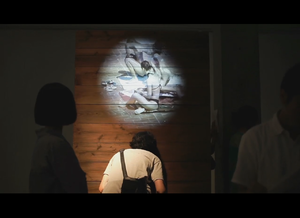Peeping Hole
Peeping Hole (2010) is an interactive installation by Kenichi Okada in collaboration with fellow artist, Naoaki Fujimoto. It was done in cooperation with the NIPPON TELEGRAPH AND TELEPHONE CORPORATION and exhibited at "The Definition of Self" directed by Masahiko Sato in 21_21 DESIGN SITE Tokyo.[1]
Exhibition Technique
This work is exhibited at "The Definition of Self" directed by Masahiko Sato in 21_21 DESIGN SITE Tokyo.[2] The exhibition takes a look at the "issue of identity through a variety of cutting-edge technologies".[3] Visitors explored the idea of a new perspective on what makes us 'us' through installations and allowed others to take a peek at our other 'self'. Peeping Hole is an installation in this exhibit that consists of a plain wooden panel with a peephole located slightly above the center. Viewers are invited to take a peek into the peephole to see whats inside. The piece is both interactive with the peeper and those standing around looking.
Formal Analysis
Peeping Hole is an installation that stands as a plain wooden panel with a peephole located slightly above the center. The hole is located just below eye level for the average viewer, viewers are invited to come closer to interact with the piece to see more. Upon interacting with the piece, an image of a beach scene is presented through the peephole. This installment interacts with the viewer's eye movement and tracks the direction of their eyes and what they choose to look at. Their eye movements are then projected above them onto the wooden panel. The viewers enter the piece are unaware of the projection; only the people around the viewers are able to see the projection of the eye tracking and experience that portion of the installment. There is a sign by the piece that provides further information to be read after interacting with the piece.
Emotional Outcomes
As the viewers step up close and peep through the hole, they interact with the piece thinking others have no way of knowing what you see on the other side. People often feel embarrassed when personal attributes they try to keep hidden are exposed to the public. [4] The viewers may have personal preferences and habits to where their eyes naturally lead them and what parts of the image they linger on. When they find out their choices were visible to everyone around them, they may feel a sense of embarrassment after this part of them is revealed. There is also a second level of interaction with this piece; not only is the viewer interacting with the piece, but the onlookers are also interacting with the piece. Since the people around the viewer are able to see what the viewer is looking at, they experience and interesting interaction by looking inside the viewer's head. [5] If the onlooker and the viewer are not strangers, they may be exposed to a different part of the viewer they do not normally see. If they are strangers, they may get to know a bit about the viewer just through experiencing their visual preferences. Kenichi states that he wanted viewers to experience the new sense of embarrassment after realizing others in the gallery knew what you were staring at. [6] The viewer is put on the spot and perhaps feel a sense of betrayal as they walk into the piece expecting only themselves to know what is happening on the other side of the peephole. Instead, they become vulnerable as they expose themselves to everyone around them and give them access to their minds.
Additional Images
Video stills from the video, 覗かれ穴 - Peeping Hole, demonstrating the work in action on Kenichi Okada's vimeo account.
References
- ↑ “peeping hole". Kenichiokada.com. Retrieved 2014-10-22.
- ↑ http://www.kenichiokada.com/projects/2010/peepinghole.html
- ↑ http://blog.artintern.net/article/171324
- ↑ “peeping hole". Kenichiokada.com. Retrieved 2014-10-23.
- ↑ “peeping hole". Kenichiokada.com. Retrieved 2014-10-23.
- ↑ “peeping hole". Kenichiokada.com. Retrieved 2014-10-23.
Wiki Authors
Chanel Huang and Jobie Hui (2014)





